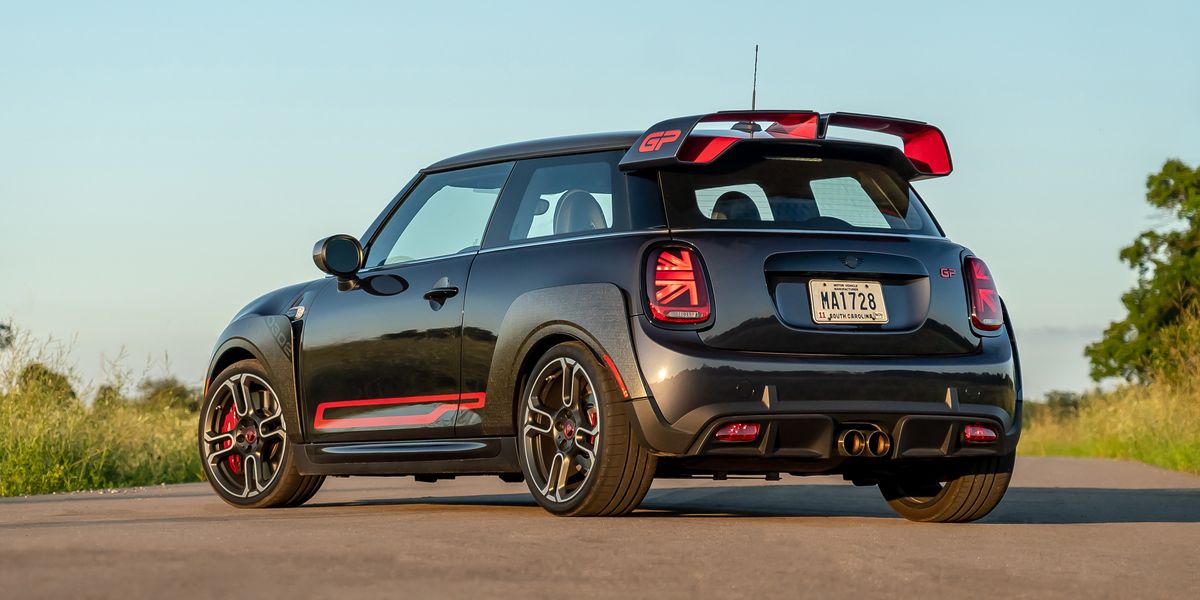Tested: 2021 Mini John Cooper Works GP Sets a Record

Mini is counting on 3000 buyers to think that a two-door Mini hardtop with 301 horsepower, carbon-fiber fender flares, and a $45,750 price is an irresistibly good idea. The Mini Cooper JCW GP is certainly a novel idea. Replacing the regular John Cooper Works’ 228-hp turbocharged 2.0-liter four-cylinder is a tweaked 301-hp version of that engine. And if the fender flares weren’t enough of a warning that this car is out to prove something, Mini removes the rear seat, making the GP a two-seater. But what exactly is this Mini out to prove? The power limits of a front-drive hot hatch? The limits of fender flares? That Mini’s product planners have lost their minds?
The GP did prove to be the quickest front-driver we have ever tested with a 4.7-second run to 60 mph. It rips through the quarter-mile in 13.1 seconds at 110 mph. The Hyundai Veloster N DCT and Honda Civic Type R come closest with 4.8- and 4.9-second times to 60, respectively. Yet, while the GP puts down some eye-opening numbers, its heady power is locked in an ongoing battle with its front tires and the driver is caught in the middle.
BMW (Mini’s parent company) uses this engine in the M235i, X2 M35i, and the JCW editions of the Mini Clubman and Countryman, but all of those vehicles come standard with all-wheel drive. Only the GP insists on making the front tires drink from the 301-hp and 332 pound-feet-of-torque firehose. All of that power rushes the 225/35R-18 Hankook Ventus S1 Evo Z tires without the torque-steer-mitigating advantage of a front strut with a separate steering knuckle, like the one used by the Civic Type R. The Mini miraculously accelerates in a straight line without much tugging or leaping across the lane. However, bend the Mini into a corner and apply the accelerator, and the limited-slip differential goes to work locking up. Suddenly, the path you selected through the corner tightens. It might not be torque steer doing the tugging, but the unrequested steering effect is just as disconcerting.
Where the Type R and Veloster N are a pleasure to throw down country roads, the GP only frustrates. Its impressive skidpad grip (0.98 g) and braking results (70 mph to zero in 151 feet) suggest that it will excel in back-road jaunts. But the ride conspires against any hope of happiness. Stiff and unyielding, the GP’s ride is irritating and borders on abusive. Your head will toss as if you’re at a Slayer concert. Ride and handling should be a compromise, not a winner-take-all competition. The GP never settles down, it never stops fidgeting, and while that’s amusing in short bursts, it gets old the more you drive it.
Earplugs are recommended for longer drives. At a steady 70 mph there’s a 77-decibel din, which is a substantial three decibels noisier than the already loud Type R. Even the 53-decibel idle is loud enough that you’ll realize you’ve been yelling into your phone after you shut off the engine. An ear-ravaging 93 decibels at wide-open throttle can’t be ignored either, and if you’re driving hard, you reach that peak often.
Driving this car on the street makes it clear that it’s optimized for a racetrack. It can turn some quick laps, but it tends toward understeer as the front tires are constantly overwhelmed by their workload. As its acceleration indicates, the GP absolutely devours straights.
Perhaps you’re wondering what sort of race-ready transmission would befit this extreme machine. Prepare for disappointment. The GP gets a conventional eight-speed torque-converter automatic, which is not something you want in your hottest of hatches. If Mini had insisted on an automatic, a dual-clutch unit with a slick launch-control function—such as the Veloster N now makes available—would have been a good start. The conventional transmission is at odds with the special nature of the GP and makes the powertrain feel not as unique as the rest of the car. Fitting a six-speed manual would likely make the GP more enjoyable on the road, but it would also likely add a few ticks to the acceleration times.
We’d gladly trade a little acceleration for the involvement of a manual. Our current pick of hot hatches, the Civic Type R, only comes with a manual. We can’t stop thinking about the hot Civic. The Mini is raw, silly, and quick, and a Type R might not be quite as raw, silly, or quick as the GP, but it’s not far off. A Type R drives better than the Mini, and it doesn’t make you suffer for having fun. The GP might be amusing in short bursts, but a Type R is the one you want to own.
This content is created and maintained by a third party, and imported onto this page to help users provide their email addresses. You may be able to find more information about this and similar content at piano.io
